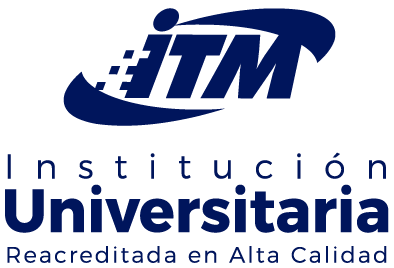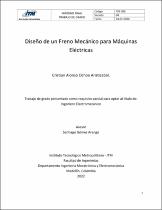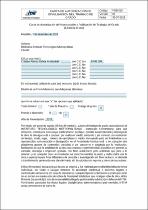Mostrar el registro sencillo del ítem
Diseño de un Freno Mecánico para Máquinas Eléctricas
| dc.contributor.advisor | Gomez Arango, Santiago | |
| dc.contributor.author | Ochoa Aristizabal, Cristian Alonso | |
| dc.date.accessioned | 2023-03-17T15:28:36Z | |
| dc.date.available | 2023-03-17T15:28:36Z | |
| dc.date.issued | 2022 | |
| dc.identifier.uri | http://hdl.handle.net/20.500.12622/5856 | |
| dc.description.abstract | Los frenos para motores eléctricos constituyen una parte fundamental en un diseño de ingeniería, son utilizados donde se requiere disminuir o parar de manera inmediata ciclos de trabajo ejercidos por el movimiento mecánico de cualquier tipo de motor, se pueden utilizar de manera segura sin afectar la integridad física de las personas y la de cualquier mecanismo. Este trabajo propone un diseño de freno mecánico para los motores y generadores del laboratorio del Instituto Tecnológico Metropolitano ITM, con el fin de optimizar mecanismo de frenado rápido. Se realizó una investigación exploratoria y teórica con base a la información de los fabricantes de motores, documentos científicos, textos de física con modelos que apliquen para el diseño del freno mecánico; el diseño describe las variables mecánicas como fuerzas de fricción, temperatura y las pruebas bajo estados de carga. Adicionalmente se calculó la velocidad del motor con su carga axial y la afectación de la potencia en la máquina. Posteriormente, con el análisis de los aspectos técnicos de los motores eléctricos, se tomaron como base las características mecánicas y los datos de información de placa por parte del fabricante y se propuso un modelo a través del software CAD- SolidWorks de diseño industrial, que permitió plantear el freno mecánico para los motores del laboratorio de máquinas eléctricas. Finalmente, se seleccionó el freno de zapata larga externa que presenta como principal ventaja un frenado práctico, un modelo para los diferentes motores del laboratorio y la capacidad de frenar los motores de una manera segura, cuando se realice cualquier práctica en el laboratorio del Instituto Tecnológico Metropolitano - ITM. Palabras clave: motor electrico, embrague, tambor, potencia, frenos, carcasa, eje, zapata, sinterización, materiales orgánicos, fricción, temperatura, velocidad, ciclos de trabajo | spa |
| dc.format.mimetype | application/pdf | |
| dc.language.iso | spa | spa |
| dc.rights.uri | http://creativecommons.org/licenses/by-nc-nd/4.0/ | * |
| dc.subject | Motor Electrico, Embrague, Tambor, Potencia, Frenos, Carcasa, Eje, Zapata, Sinterización, Materiales Orgánicos, Fricción, Temperatura, Velocidad, Ciclos de Trabajo | spa |
| dc.title | Diseño de un Freno Mecánico para Máquinas Eléctricas | spa |
| dc.publisher.faculty | Facultad de Ingenierías | spa |
| dc.publisher.program | Ingeniería Electromecánica | spa |
| dc.subject.keywords | Electric Motor, Clutch, Drum, Power, Brakes, Casing, Shaft, Shoe, Sintering, Organic Materials, Friction, Temperature, Speed, Work Cycles | spa |
| dc.subject.lemb | Diseño de máquinas | spa |
| dc.subject.lemb | Diseño en ingenieria | spa |
| dc.subject.lemb | Frenos | spa |
| dc.subject.lemb | Velocidad | spa |
| dc.subject.lemb | Movimiento rotatorio | spa |
| dc.description.abstractenglish | Brakes for electric motors are a fundamental part of an engineering design, they are used where it is required to immediately reduce or stop work cycles exerted by the mechanical movement of any type of motor, they can be used safely without affecting the integrity physics of people and that of any mechanism.This work proposes a mechanical brake design for the motors and generators of the laboratory of the Instituto Tecnológico Metropolitano ITM, in order to optimize the fast braking mechanism.An exploratory and theoretical investigation was carried out based on information from engine manufacturers, scientific documents, physics texts with models that apply to the design of the mechanical brake; the design describes the mechanical variables such as friction forces, temperature and the tests under states of load. Additionally, the speed of the motor with its axial load and the affectation of the power in the machine were calculated.Subsequently, with the analysis of the technical aspects of the electric motors, the mechanical characteristics and the information on the manufacturer's nameplate were taken as a basis and a model was proposed through the CAD-SolidWorks industrial design software, which allowed raise the mechanical brake for the motors of the laboratory of electrical machines. Finally, the external long shoe brake was selected, which presents practical braking as its main advantage, a model for the different motors in the laboratory and the ability to brake the motors in a safe way, when any practice is carried out in the laboratory of the Technological Institute. Metropolitan - ITM. Keywords: electric motor, clutch, drum, power, brakes, casing, shaft, shoe, sintering, organic materials, friction, temperature, speed, work cycles | spa |
| dc.description.degreename | Ingeniero Electromecánico | spa |
| dc.identifier.instname | instname:Instituto Tecnológico Metropolitano | spa |
| dc.identifier.reponame | reponame:Repositorio Institucional Instituto Tecnológico Metropolitano | spa |
| dc.identifier.repourl | repourl:https://repositorio.itm.edu.co/ | |
| dc.rights.local | Acceso abierto | spa |
| dc.rights.accessrights | info:eu-repo/semantics/openAccess | |
| dc.rights.creativecommons | Attribution-NonCommercial-NoDerivatives 4.0 International | * |
| dc.title.translated | Design of a Mechanical Brake for Electrical Machines | spa |
| dc.type.local | Trabajo de grado de pregrado | spa |
| dc.type.coar | http://purl.org/coar/resource_type/c_7a1f | spa |
| dc.type.driver | info:eu-repo/semantics/bachelorThesis | spa |
| dc.description.degreelevel | pregrado | spa |




